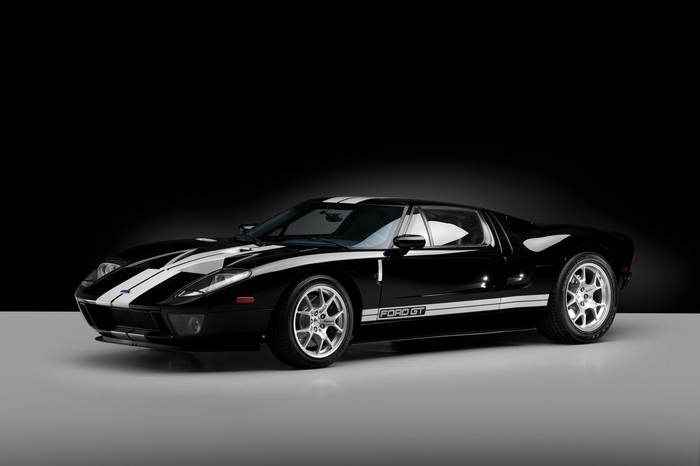SCM Analysis
Detailing
| Vehicle: | 2005 Ford GT |
| Number Produced: | 4,038 |
| Original List Price: | $149,995 |
| Tune Up Cost: | $850 |
| Engine Number Location: | Bar code sticker on valve cover |
| Club Info: | FordGT, Ford GT Forum |
| Website: | http://www.fordgt.org |
This 2005 Ford GT, Lot 845, sold for $242,000, including buyer’s commission, at RM’s Dingman Collection sale on June 6, 2012. Throw your Kelly Blue Books away; we are about to enter the realm of Ford GT values.
From the moment Ford introduced the modern GT40 concept car in 2002, it was a superstar. Chief designer Camilo Pardo and his team at Ford’s “Living Legends” studio simply nailed it, remaining true to the original Le Mans-winning legend, while creating a modern supercar that is still relevant today.
Willing buyers lobbied Ford to put the car into production, and once it became official, the game was on. I attended the Christie’s Pebble Beach auction in August 2003 to watch Ford sell Chassis #10 for charity, and SCMer Jon Shirley was the lucky high bidder at $557,500. That only furthered the FGT feeding frenzy that was already in place.
Rocketing out of the gate
When Ford announced the original MSRP of $139,995, it was irrelevant, as buyers were willing to pay upwards of $100k over sticker to get one, and dealers were only too willing to type up those “Additional Dealer Markup” addendums to Ford’s window stickers. Soon, the fittingly named www.fordgtprices.com website went live and started tracking Ford GT prices and listings. It was the virtual barometer of the market.
Most all Ford GTs came “loaded” with all four options Ford offered: BBS wheels, McIntosh stereo, Le Mans stripes and painted brake calipers. These four options combined added roughly $13,500 to the base price. Powered with a 5.4-liter, 550-hp, supercharged V8 with a 6-speed transmission, the top speed is limited to 205 mph, with a 0–60 mph time of under 3.5 seconds.
The Shelby American Automobile Club has tracked Ford GTs by serial number for their World Registry since the beginning. Some more entertaining histories show cars being sold as many as 10 times in the first 12 months before finding more permanent homes.
An expected stall, a surprising rise
Like any instant collectible with huge premiums, supply soon met demand (or at least got close) and prices stabilized. By 2007, you could buy a new Ford GT for near MSRP, and once many became “just used cars,” prices dropped further — especially for cars with miles on them or damage history. Wise buyers scanned wreckedexotics.com/gt40 (yes, really) to see whether the car they were considering was a past feature car.
And then something happened that shocked even Ford GT owners — prices started to go up. This happens with very few modern supercars, and usually not within the first decade (the Ferrari F40 is one of the few exceptions I can think of). Today, a near-new 2006 Ford GT with low miles will easily sell for $175k-plus —roughly $15k over MSRP — and demand for great examples again outstrips supply.
Why the bump? I attribute it to the fact that Ford GTs are a stunning and usable supercar that appeals to many buyers who wouldn’t consider a Ferrari or Lamborghini. The Ford GT is a truly exotic modern American supercar. You cannot take one anywhere without drawing a crowd or stopping traffic; they are that impressive in person. Bang for the buck, I contend a Ford GT is nearly impossible to beat.
As for Michael Dingman’s Chassis #02 car, while the market typically favors later (2006) cars to avoid some well-publicized early car bugs, the opportunity to get the lowest serial number production car that will ever be available trumps all else. It is also an essentially zero-mile car in the right colors, and the Dingman provenance is among the best you can get — right up there with Jay Leno’s or Jon Shirley’s Ford GTs.
I viewed RM’s pre-sale estimate of $325,000–$375,000 as spot-on, and the $242,000 all-in result surprised me. This FGT brought a very small premium over market pricing for a “regular” GT, and I consider it extremely well bought. ?
(Introductory description courtesy of RM Auctions.)
